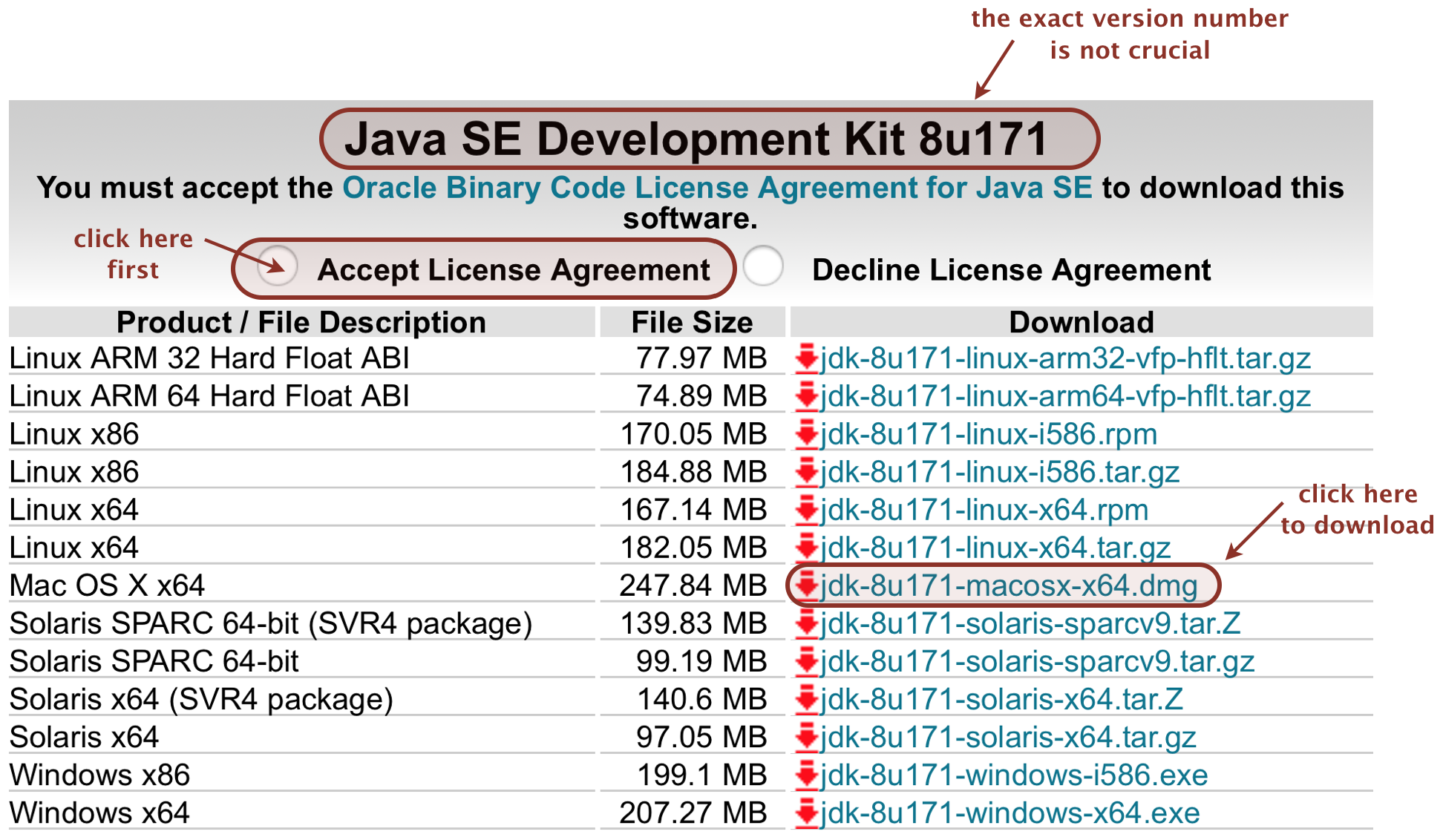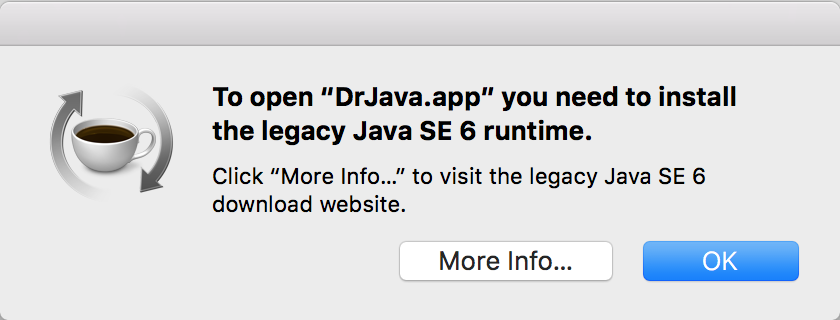Hello World in Java on Mac OS X
This DrJava-based Java programming environment is no longer being supported
(because DrJava in no longer being actively developed and DrJava is incompatible with Java 11).
It has been replaced by the following IntelliJ-based programming environment for
Mac OS X.
This document instructs you on how to set up our Java programming environment for your Mac OS X computer. It also provides a step-by-step guide for creating, compiling, and executing a Java program using either DrJava or the Terminal. All of the software used is freely available.
You will need an Intel-based Mac running Mac OS X 10.8 (Mountain Lion) to Mac OS X 10.13 (High Sierra).
You can defer steps 4–6 until Section 1.5 of the textbook.
|
|
Our installer downloads, installs, and configures
the Java programming environment you will be using,
including DrJava, and the standard libraries from our textbook.
- Log in to the user account in which you will be programming. Your account must have Administrator privileges (with a non-blank password) and you must be connected to the Internet.
-
Install Oracle's implementation of the Java Platform, Standard Edition Development
Kit (JDK 8).
Do not install either JDK 9 or JDK 10, as they are currently incompatible with DrJava.
- Browse to
Java SE Development Kit 8u171.
In the first table, check Accept License Agreement
and the click jdk-8u171-macosx-x64.dmg,
which corresponds to the entry for Mac OS X.
The exact verison 8u171 is not essential.

- Double click the downloaded file jdk-8u171-macosx-x64.dmg to begin the installation. Enter your OS X password when prompted. We recommend all of the default options.
- Delete jdk-8u171-macosx-x64.dmg.
- Browse to
Java SE Development Kit 8u171.
In the first table, check Accept License Agreement
and the click jdk-8u171-macosx-x64.dmg,
which corresponds to the entry for Mac OS X.
The exact verison 8u171 is not essential.
-
To install,
- Download introcs.zip to the Desktop; double-click it to unzip (if necessary). This creates introcs.app.
- Double-click introcs.app to perform the installation. If you receive a warning that introcs.app is an application downloaded from the Internet, click Open.
- Enter your OS X password when prompted.
-
If the installation succeeds, you will see the following:
- A Terminal window containing approximately this execution log.
- A Standard Drawing window containing a red bullseye and a textbook graphic.
- Delete introcs.zip and introcs.app.
|
|
Now you are ready to write your first Java program.
You will develop your Java programs in an application called DrJava.
DrJava features many specialized programming tools including syntax highlighting,
bracket matching, auto indenting, and line numbering.
- The installer creates a shortcut to DrJava on the desktop. Double-click it to launch DrJava. If you receive a warning about incoming network connections, click Allow.
-
In the main DrJava window, type the Java program
HelloWorld.java exactly as it appears below. If you omit even a semicolon,
the program won't work.
As you type, DrJava does the indenting for you.public class HelloWorld { public static void main(String[] args) { System.out.println("Hello, World"); } } - Finally, click the Save button to save the file, using the name HelloWorld.java. The filename is case sensitive and must exactly match the name of the class in the Java program.
|
|
It is now time to convert your Java program into a form more amenable for
execution on a computer. To do this, click the Compile button.
If all goes well, you should see the following message in the Compiler Output
pane at the bottom:
If DrJava complains in some way, you mistyped something. Check your program carefully, using the error messages in the Compiler Output pane as a guide.
|
|
Now it is time to run your program. This is the fun part.
-
Type the following in the Interactions pane at the bottom.
By convention, we highlight the text you type in boldface.
If all goes well, you should see the following message:> java HelloWorld
Welcome to DrJava. Working directory is /Users/<username>/Desktop > java HelloWorld Hello, World
- You may need to repeat this edit–compile–execute cycle a few times before it works. Ask for help if you can't see the mistake.
|
|
The command-line provides capabilities beyond those available in DrJava,
including redirection and piping.
You will type commands in an application called the Terminal.
-
The installer creates a shortcut on the desktop to the Terminal.
Double-click it to launch the Terminal.
You should see something like:
The ~ is shorthand for your home directory /Users/<username>.machine:~ <username>$
-
To confirm that the Java compiler is installed,
type the command in boldface below and check that the results match:
It's important that you see the number 1.8 for the Java version number, but the rest is not critical.machine:~ <username>$ javac -version javac 1.8.0_171
-
To confirm that you the Java interpreter is installed, type
the command in boldface below and check that the results match:
Again, it's important that you see the number 1.8 for the Java version number, but the rest is not critical.machine:~ <username>$ java -version java version "1.8.0_171" Java(TM) SE Runtime Environment (build 1.8.0_171-b16) Java HotSpot(TM) 64-Bit Server VM (build 1.8.0_171-b16, mixed mode)
|
|
You will use the javac command to convert your Java program into a form more amenable for execution on a computer.
-
From the Terminal, navigate to the directory containing HelloWorld.java,
say ~/Desktop/hello,
by typing the cd (change directory) commands below:
The ~ is shorthand for /Users/<username>.machine:~ <username>$ cd Desktop machine:~/Desktop <username>$ cd hello machine:~/Desktop/hello <username>$
-
Compile it by typing the javac command below:
Assuming the file HelloWorld.java is in the current working directory, you should see no error messages.machine:~/Desktop/hello <username>$ javac HelloWorld.java machine:~/Desktop/hello <username>$
-
To make our textbook standard libraries accessible to Java,
use the command javac-introcs instead.
For example,
BouncingBall.java
is a program that uses our standard drawing library.
After downloading the file to the current directory,
you can compile it with the following command:
machine:~/Desktop/hello <username>$ javac-introcs BouncingBall.java
|
|
You will use the java command to execute your program.
-
From the Terminal, type the java command below.
You should see the output of the program.machine:~/Desktop/hello <username>$ java HelloWorld Hello, World
-
To make our textbook standard libraries accessible to Java,
use the command java-introcs instead. For example, to execute
BouncingBall.java
(assuming you downloaded and compiled it in the previous step), type the following command:
machine:~/Desktop/hello <username>$ java-introcs BouncingBall [ displays a bouncing ball in a graphics window ]
|
|
How long should the installer take?
Once downloaded, the Oracle Java installer should take about 10 seconds and the introcs.app
installer should take about 20 seconds. If you have virus detection software running (such
as McAfee Endpoint), each could take 5–10 minutes (or more).
The installer didn't work on my machine. What should I do? Check out the following three Q+As. If these don't resolve the issue, please contact a staff member to identify what went wrong.
When I run the installer, the terminal window just waits after asking for a password. But, I don't even have a password-enabled account. You must have a non-blank password. Here are instructions for resetting a user's password.
When I run the installer, I get the error message "bash: /Volumes/Macintosh: No such file or directory". Your user account and OS must be on the same volume.
When I run the installer, I get an error like bash: /private/var/folders/70/n8stth1d1x33hrw8n07kf1280000gn/T/AppTranslocation/45FC25B7-17E3-46DF-AC27-9A7EF56DDFD3/d/algs4.app/Contents/Resources/launcher.sh: No such file or directory. What should I do? This is likely due to OS X Sierra path randomization. Use the Finder to move introcs.app to some other folder and try again.
What does the installer do? In short, it downloads, installs, and configures Checkstyle, Findbugs, and DrJava, and the textbook standard libraries. Here is a more detailed list:
- Checks that Java is installed.
- Downloads the textbook standard libraries from stdlib.jar.
- Downloads the Java wrapper scripts javac-introcs and java-introcs.
- Downloads and installs Findbugs 3.0.1 from findbugs.zip. Downloads our findbugs configuration file findbugs.xml and wrapper script findbugs-introcs.
- Downloads and installs PMD 5.8.1 from pmd.zip. Downloads our PMD configuration file pmd.xml and wrapper script pmd-introcs.
- Downloads and installs Checkstyle 8.2 from checkstyle.zip. Downloads our checkstyle configuration file checkstyle-introcs.xml and wrapper script checkstyle-introcs.
- Downloads and installs the latest stable version of DrJava, from DrJava.zip. Creates a shortcut to DrJava on the Desktop. Downloads and installs the DrJava configuration file from drjava-config.txt to /Users/<username>/.drjava. Note that this will overwrite any existing .drjava configuration file.
- Tests that the installation succeeded by compiling and executing TestIntroCS.java.
Why does the installer need my password? The installer copies files into /usr/local/bin and /usr/local/introcs, which require superuser privileges.
How do I completely uninstall introcs.app?
- Delete the directory /usr/local/introcs.
- To uninstall DrJava, delete the following two files:
- /Applications/DrJava.app.
- /Users/<username>/.drjava.
- To uninstall the Java, Checkstyle, and Findbugs wrapper scripts,
delete the following files:
- /usr/local/bin/javac-introcs
- /usr/local/bin/java-introcs
- /usr/local/bin/findbugs-introcs
- /usr/local/bin/pmd-introcs
- /usr/local/bin/checkstyle-introcs
- Delete the shortcut to DrJava and Terminal on the Desktop.
What happens if I re-run the installer? It will re-download, install, and configure Checkstyle, Findbugs, DrJava, and our textbook libraries.
Can I use a different version of Java? Any version of Java 8 (either Oracle or OpenJDK) should work fine. Note that DrJava does not currently work with Java 9.
I have both Java 8 and Java 9 installed, but the default version is Java 9. How do I change the default version back to Java 8? To disable Java 9, type the following commands in the Terminal:
You should still be able to use Java 9 by specifying the full path to
javac and java, e.g.,
/Library/Java/JavaVirtualMachines/jdk-9.0.1.jdk/Contents/Home/bin/javac.
Why I try to run DrJava, I get the following error message. How should I proceed?
Are you sure that you are using the version of DrJava that was installed by our auto-installer (and not downloaded from the DrJava website)? We suggest deleting any older versions of DrJava and using the one that the auto-installer copied to the /Applications directory.
Can I use a different IDE? Yes you can use another IDE (such as Eclipse) but you will have to configure the IDE properties yourself (such as the classpath).
When I compile or execute a program in Terminal that uses the textbook standard library, I get an error that it cannot find the library. How can I fix this? Use the wrapper scripts javac-introcs and java-introcs, which add stdlib.jar to the Java classpath.
Which shell should I use in the Terminal? Bash is the default shell in Mac OS X, but feel free to use whichever one you prefer.
Where can I learn more about the command line?
Here is a short tutorial on the
command line.


